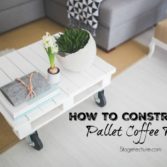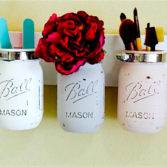Entry #587, July 14, 2011
If you’re trying to make the grounds, or exterior portions of your home look better, you need to focus on curb appeal boosting ideas. Especially when selling your home, your curb appeal can make or break the buyers opinion about your home, before they even step inside your home.
Whether you want to boost the curb appeal for yourself or just to compete with your neighbors fabulous lawn.. here are some tips from DIY Life.
_________________
With all the effort we expend in making the interiors of our homes look passable, sometimes curb appeal — the way our homes look on the outside — falls by the wayside.
What if you don’t have the budget to revamp your entire facade? Don’t sweat it. There are a host of easy, inexpensive DIY fixes that can pump up the volume of an otherwise ho-hum exterior. Here are eight ideas to get you started. Even better? Each one of the following projects costs no more than $50.

1. Invest in some cool house numbers.
Switch out those tired old digits and give your address a makeover. House numbers can be screwed in or easily glued on with adhesive — and there’s a staggering array of styles and materials to choose from — check out the vast array of modern house numbers by Atlas Homewares (about $12 to $20 per number). For even more oomph, paint or stain a tall newel post ($25 to $50) the same color as your front door or shutters, then attach some new, stylized numbers and sink it into the ground either at the end of your driveway or near your home’s entry. (Best to expect some neighborly copycatting on that one.)

Getty images
2. Upgrade the front door hardware.
Basic front door hardware is a cinch to replace. You’ll find a wide array of bells, doorknockers and escutcheons (plates surrounding bells, keyholes, knobs) at hardware stores and flea markets (from $5 to $30). A doorbell upgrade (under $30) is also easy, as there’s often no need to replace the actual chime — just the hardware surround. (But if you do want to switch out the entire doorbell, there’s only minor rewiring involved.) A kick plate (about $33) — typically made of polished metals like rustic pewter, aged bronze, or satin nickel — boosts a door’s “wow” factor while shielding it from stains and scuff marks. First, measure the width of your door — since most are 36 inches wide, you’ll need to screw in a plate that’s either 6 inches high by 34 inches wide, or 8 inches high by 34 inches wide. Buy one with a clear, rust- and corrosion-resistant finish. Understandably, switching the lockset (about $22 and up) is the most costly change you’ll make to the entry, as protection is priority. Sink screws into preexisting holes, or do some bush-league drilling. For a cohesive, stylized look, choose accents with the same finishes, and be sure they’re stylistically similar to your home’s design.
3. Repaint or stain a wood door.
If you’re not ready to spring for a new door, this is the way to go. There’s no excuse for the front door looking anything but shipshape because paint and stain are so inexpensive (around $32 per gallon of paint/primer; around $12 for 32 ounces of stain — or potentially free if you have some lying around). Door and hardware removal comes first (or you can tape around hinges and knobs if you’re feeling confident and have a steady hand). Next, surfaces need sanding (fine, 180-grit paper should suffice), dusting, priming and two to three coats of paint. Go with the grain; follow the same procedure with stain and varnish.

Corbis
4. Tidy up the landscaping.
Has your home ever been referred to as Grey Gardens? Time to break out the pruners. It costs little to nothing (except for time clocked) to trim overgrown hedges, edge walkways, pull up weeds and cut out dead growth. Transplanting is free, too: Move those gorgeous dahlias to the front yard, where they’re sure to be noticed. Also, clip massive hedges that inhibit views from the inside out. Mulch is another winner: Spread a layer of grass clippings (free, collected from a lawnmower), straw (about $4 per bale at your local garden center or nursery) or tree bark-based mulch (about $12 for 2 cubic-feet at garden centers and nurseries, or sometimes offered for free by your town after it has chipped dead trees) at the bases of trees and flowerbeds. Doing so not only protects plantings and improves soil quality, but beautifies your yard, too. How much will you need? Use an online calculator: just plug in the area’s square footage and desired thickness.

The Home Depot
5. Replace light fixtures.
Strategically placed lighting always goes a long way. It highlights lovely landscaping and all the other wonderful things you’ve done to your home. Size and scale matter here, as does general attractiveness and brightness. (NASA shouldn’t be able to see your home from space.) Match the style and finish of the new lights to other elements in your entry and you’re generally good to go. Expect to pay about $25 each for brushed copper Flemish-style lights and around $30 for a slick, industrial stainless-steel lantern. You can also opt for solar-powered lights, which have three significant advantages over their hard-wired electric counterparts: There’s no assembly required, they save energy and you can move them around with little effort. Sink a few attractive lantern-style lights ($18 for six) into the soil that flanks walkways and the driveway. You’ll be amazed at how good this actually makes a home look.

Getty images
6. Upgrade the mailbox.
Wobbly, dented mailboxes are unsightly. (Everyone would rather forget about last season’s nasty snowplow incident.) Changing the box is a great way to add personality. Installation of a bold door-side mailbox (about $50) requires only some simple drilling. A good-looking, durable freestanding mailbox ($40 to $50) just needs a hole dug for the post.

Getty images
7. Dress up (and clean!) those windows.
Good-looking architectural details are no longer prohibitively expensive, or difficult to add on. Mullions, moldings and decorative brackets can really make your exterior pop, and installation is as easy as clicking in a PVC grid (a sample mullion kit costs $22 and covers 12 square-feet of glass) over existing windows, or screwing wooden brackets (about $21 each) into existing structures. Sometimes, the act of simply cleaning the windows — inside and out — is all you’ll need to massively improve the view. Dish detergent (or plain old vinegar) and a microfiber rag (or a piece of newspaper!) should do the trick. For hard-to-reach windows, use a cleaner formulated for outdoor use (about $10 for 32 ounces at hardware stores) that attaches to your hose. It should dry to a smudge-free finish, and there’s no need to remove screens. Just wash on a cloudy, non-windy day, as breezes and sunlight dry panes too quickly, leaving unsightly streaks behind.
8. Wash dirty siding and dingy decking.
You could pressure wash any type of siding (save for wood shingles), but you’ll pay upwards of $100 to rent or buy a machine — and possibly do some major damage in the process. Instead, use some good old elbow grease, your garden hose (on a medium-spray setting), a long-handled scrub brush and a bucketful of water mixed with a few squirts of dish soap. For wood porches and decks, oxygen bleach (about $13 for 56 per container, at supermarkets) is the way to go. Plus, it’s nontoxic to you, and to pets and vegetation. Mix a few scoops into a bucketful of water, dip the brush and scrub away.
For more outdoor living ideas on Stagetecture, click here.
Receive Stagetecture's Daily Lifestyle Ideas
FREE - Daily emails with recipes, home decor, D.I.Y, and lifestyle tips! : ) Who doesn't need help?






Leave a Reply